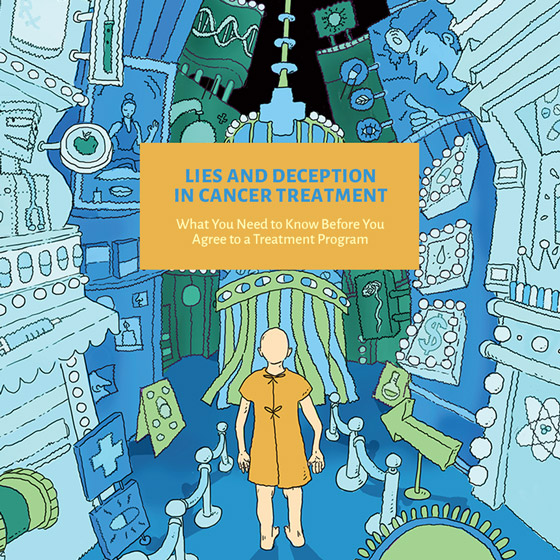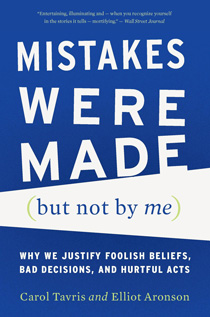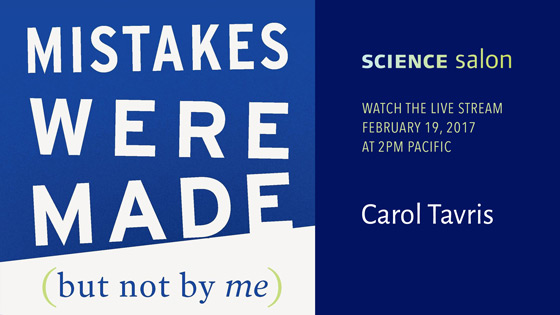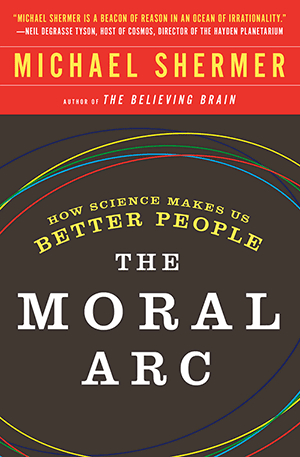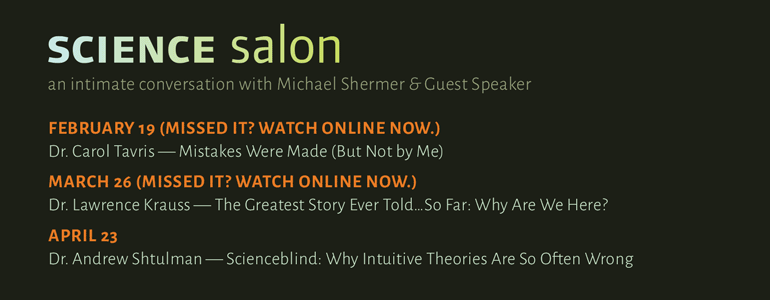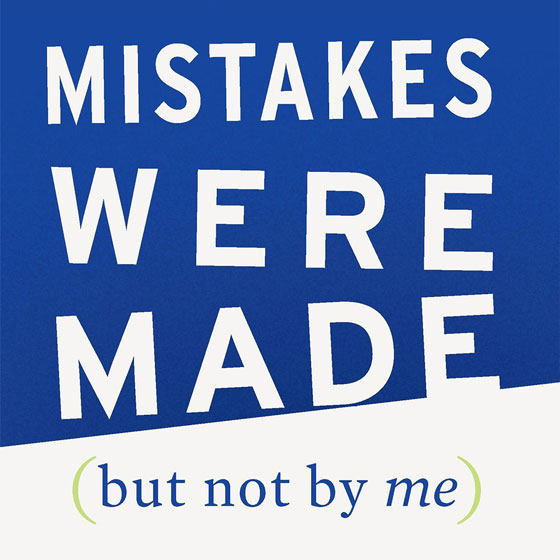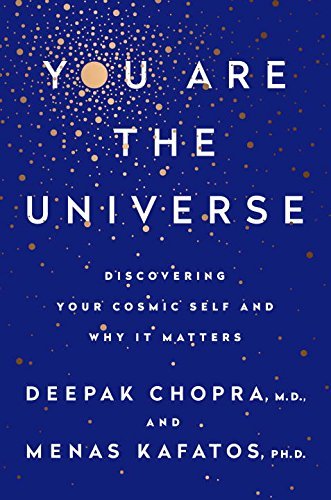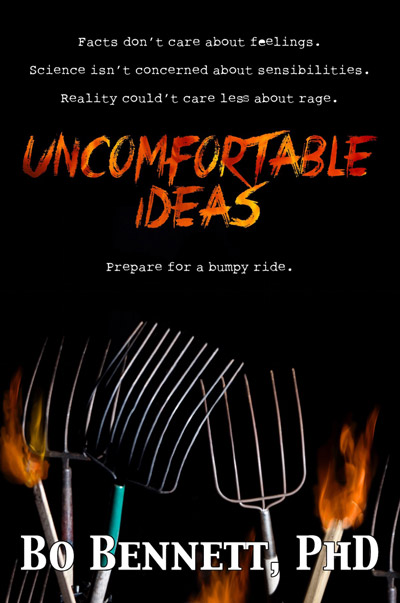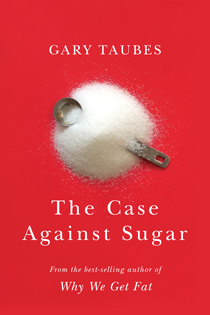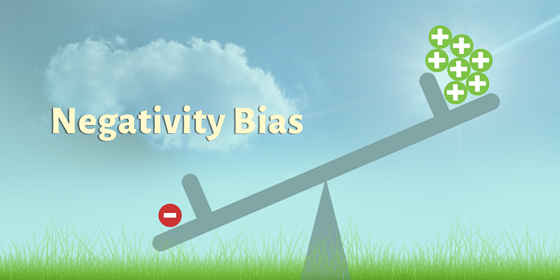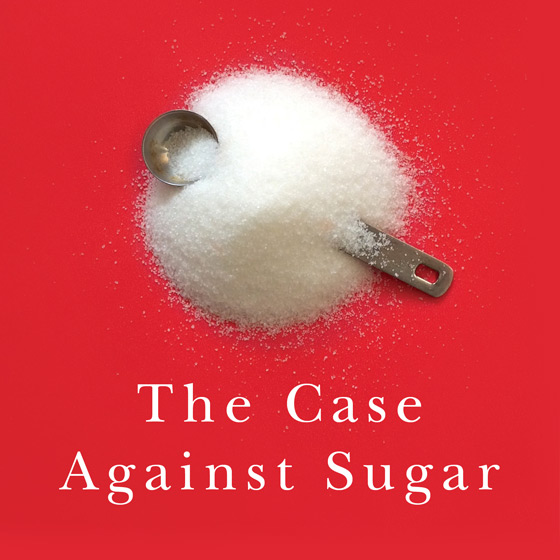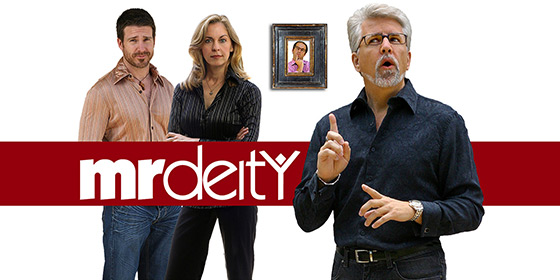eSkeptic for April 5, 2017
In this week’s eSkeptic:
SCIENCE SALON # 11: APRIL 23
Dr. Andrew Shtulman — Scienceblind: Why Our Intuitive Theories About the World Are So Often Wrong
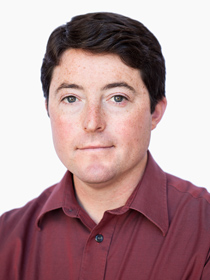
Photo by Max S. Gerber
Why do we catch colds? What causes seasons to change? And if you fire a bullet from a gun and drop one from your hand, which bullet hits the ground first? In a pinch we almost always get these questions wrong. Worse, we regularly misconstrue fundamental qualities of the world around us. So, how do we get the world right? Find out in this Science Salon!
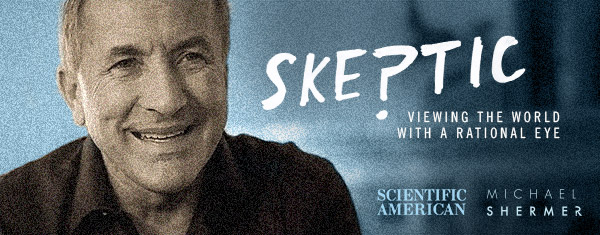
SCIENTIFIC AMERICAN “SKEPTIC” COLUMN FOR APRIL 2017
What is Truth, Anyway? How to think about claims, even the Resurrection
According to the Oxford English Dictionary’ s first definition, a “skeptic” is “one who holds that there are no adequate grounds for certainty as to the truth of any proposition whatever.” This is too nihilistic. There are many propositions for which we have adequate grounds for certainty as to their truth:
There are 84 pages in this issue of Scientific American. True by observation.
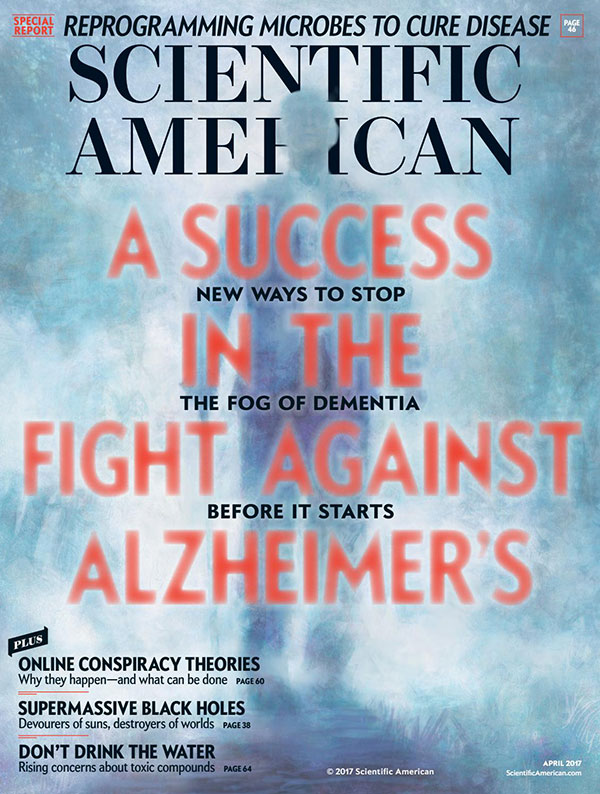
Dinosaurs went extinct around 65 million years ago. True by verification and replication of radiometric dating techniques for volcanic eruptions above and below dinosaur fossils.
The universe began with a big bang. True by a convergence of evidence from a wide range of phenomena, such as the cosmic microwave background, the abundance of light elements (such as hydrogen and helium), the distribution of galaxies, the large-scale structure of the cosmos, the redshift of most galaxies and the expansion of space.
These propositions are “true” in the sense that the evidence is so substantial that it would be unreasonable to withhold one’s provisional assent. It is not impossible that the dinosaurs died a few thousand years ago (with the universe itself having been created 10,000 years ago), as Young Earth creationists believe, but it is so unlikely we need not waste our time considering it.
Man’s Best Fiend
MONSTERTALK EPISODE 125
In this episode of MonsterTalk, we are joined by folklorist and author Mark Norman to discuss legends of black hounds. Mark is the author of Black Dog Folklore as well as the host of The Folklore Podcast. This is a special cross-over episode with The Folklore Podcast and contains a slightly different edit of the interview audio. Discussion ranges from the legends of dark hounds in European folklore, to the nature of the academic study of folklore.
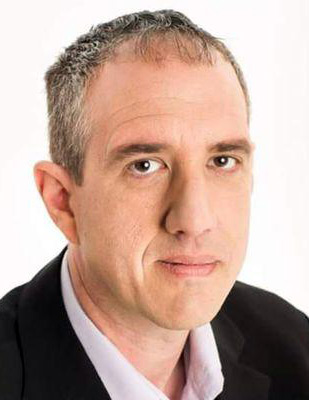
Mark Norman
Get the MonsterTalk Podcast App and enjoy the science show about monsters on your handheld devices! Available for iOS, Android, and Windows devices. Subscribe to MonsterTalk for free on iTunes. Follow the RSS feed.
eSkeptic for March 29, 2017
In this week’s eSkeptic:
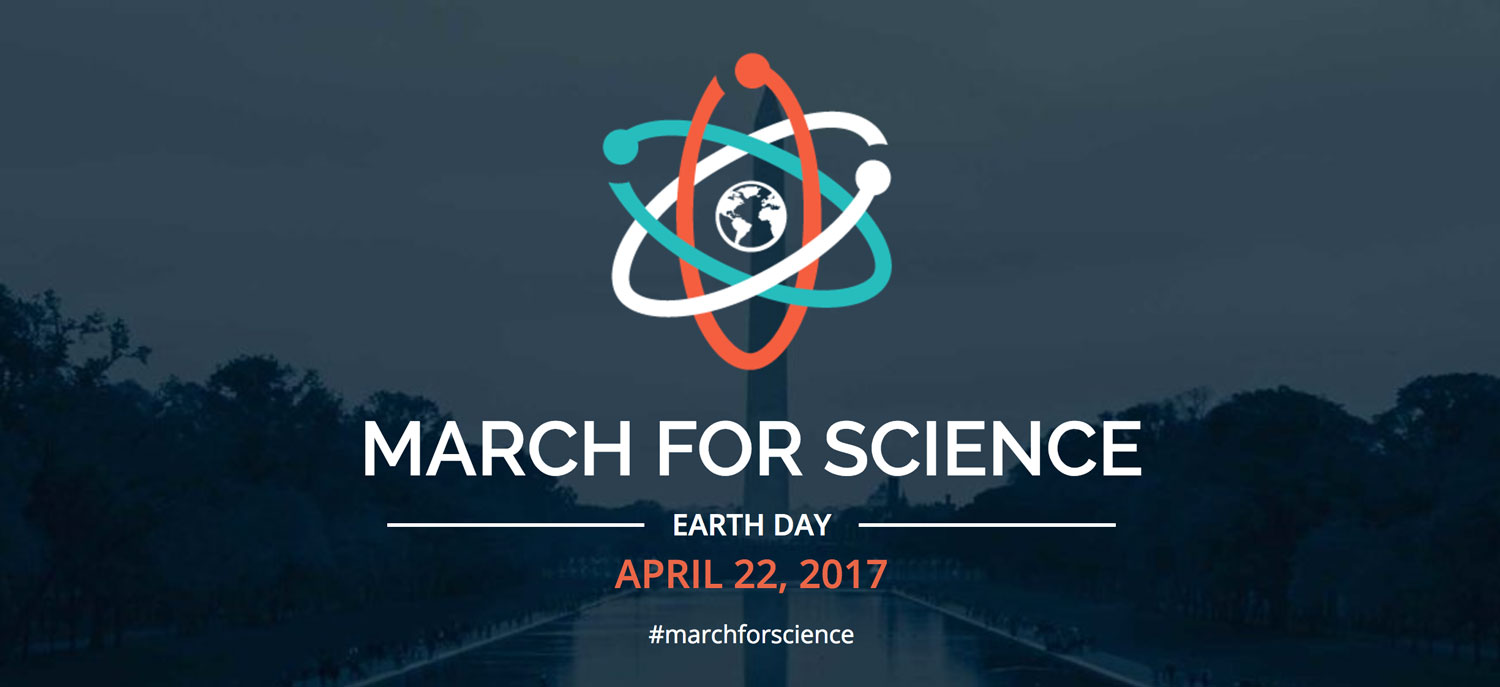
MICHAEL SHERMER BLOG
Science for All
On 22 March, 2017 I posted on my Twitter account (@michaelshermer) a link to this article titled “Science march on Washington, billed as historic, plagued by organizational turmoil,” which chronicled the “infighting among organizers, attacks from outside scientists who don’t feel their interests are fairly represented, and operational disputes.” The article went on to note that “Tensions have become so pronounced that some organizers have quit and many scientists have pledged not to attend.” Predictably, politics was the divisive element, most notably identity politics involving the proper representation of race and gender diversity, and immigration, obviously in response to the election of Donald Trump. The website of the march felt the need to post an official diversity policy that reads, in part, “We acknowledge that society and scientific institutions often fail to include and value the contributions of scientists from underrepresented groups.”
My initial thought was this: So let me get this straight. As the Federal government prepares to cut science budgets across the board, and in an era of fake news and alternative facts, instead of marching to proclaim how important science is to the American economy, not to mention human survival and flourishing, along with our commitment to facts and reason, you want to send a message to the public in general and the Trump administration in particular that science—the most universal institution in human history—is a failure when it comes to diversity and inclusion? […]
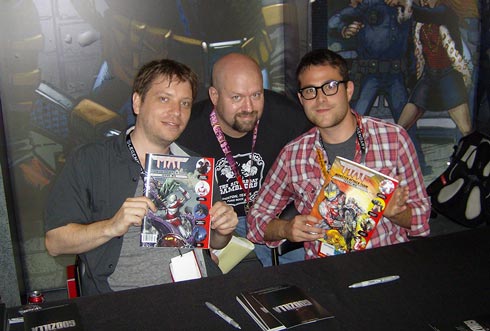
Mike Keller (center) pictured with Gareth Edwards (left), Director Godzilla 2014, and Max Borenstein (right), screenplay Kong: Skull Island
Crush, Crumble and Chomp
MONSTERTALK EPISODE 124
This MonsterTalk is another special literary/pop-culture episode as we take on the biggest topic in monsters: Giant City-Destroying Kaiju! Guests are Ed Godziszewski author of Ishiro Honda: A Life in Film, from Godzilla to Kurosawa (Oct 2017) and Michael Keller, co-author (with Edward Holland) of the magazine Monster Attack Team and the upcoming podcast Area 42.
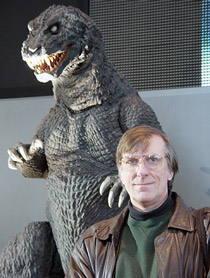
Ed Godziszewski (right) pictured with Godzilla, King of the Monsters (left)
Get the MonsterTalk Podcast App and enjoy the science show about monsters on your handheld devices! Available for iOS, Android, and Windows devices. Subscribe to MonsterTalk for free on iTunes. Follow the RSS feed.
Dying To Go To Heaven
What the Heaven’s Gate Suicides Teach Us About Islamic Martyrdom
by Michael Shermer
It was 20 years ago this week, March 20-26, 1997, that 39 members of the Heaven’s Gate cult “graduated” from this life to ascend to the UFO mothership that they believed would take them to an extraterrestrial paradise. I’ll never forget it. I was on book tour for Why People Believe Weird Things, and neither I nor any of my peers who study belief systems had ever heard of the cult. It was hard to fathom. Now, as I look back 20 years later, I believe the mass suicide has a deeper lesson that goes far beyond the confines of New Age fringe cults, and has relevance to understanding the motivations of today’s suicide terrorists.
But first, let’s revisit the story. Heaven’s Gate was founded in 1975 by Marshall Applewhite and Bonnie Nettles after they met in a psychiatric hospital. They fell in love and believed their pairing had been foretold by extraterrestrials. In the 1980s and 1990s, they recruited several hundred followers, many of whom sold their possessions and lived in isolation, disconnected from their family and friends. They practiced living in dark rooms to simulate space travel and considered sex sinful, with six male members voluntarily undergoing castration.
In early 1997, the appearance of Comet Hale-Bopp foretold to them that the coming of the UFO mothership, said to be hiding behind the comet, that would take them to what they called The Evolutionary Level Above Human (TELAH), where they would live forever in unadulterated ecstasy. This story was reinforced by Art Bell, on his popular late-night radio show Coast to Coast AM, a purveyor of conspiratorial “alternative facts” (before they were known as such). Compared to eternal bliss in this extraterrestrial heaven, life on Earth was but a temporary stage in evolution. The transition was made in three waves that week, as members drank a deadly cocktail of phenobarbital, applesauce, and vodka; also pulling plastic bags over their heads for self-asphyxiation. Authorities found them all dead in a San Diego home on March 26. The event became a media circus. […]
SCIENCE SALON # 11: APRIL 23
Scienceblind: Why Our Intuitive Theories About the World Are So Often Wrong
Why do we catch colds? What causes seasons to change? And if you fire a bullet from a gun and drop one from your hand, which bullet hits the ground first? In a pinch we almost always get these questions wrong. Worse, we regularly misconstrue fundamental qualities of the world around us. In Scienceblind, cognitive and developmental psychologist Dr. Andrew Shtulman, a professor of psychology and cognitive science at Occidental College, where he directs the Thinking Lab, shows that the root of our misconceptions lies in the theories about the world we develop as children. They’re not only wrong, they close our minds to ideas inconsistent with them, making us unable to learn science later in life.
So how do we get the world right? We must dismantle our intuitive theories and rebuild our knowledge from its foundations. The reward won’t just be a truer picture of the world, but clearer solutions to many controversies—around vaccines, climate change, or evolution—that plague our politics today.
Order Scienceblind: Why Our Intuitive Theories About the World Are So Often Wrong from Amazon.
Call 1-626-794-3119 now to reserve.
eSkeptic for March 22, 2017
In this week’s eSkeptic:
MEDIA
Michael Shermer Sizzle Reel
See clips from Dr. Michael Shermer’s most noted media appearances including: twice on the Colbert Report, Larry King Live with UFOlogists, CNN, and other news shows debating creationists and Intelligent Design advocates, and other highlights from his 25 year career as a public intellectual.

Are abused children doomed to repeat the crimes of their abusers? In this week’s eSkeptic, Carol Tavris examines our intuition about the “cycle of abuse.” This column was originally published in Skeptic magazine 21.2 (2016).
How Accurate is the “Cycle of Abuse”?
by Carol Tavris
Many years ago, as I was sitting in a courtroom waiting to testify as an expert witness in a case involving junk psychology, I observed a child custody case ahead of ours. A social worker was arguing that the mother in question should not be granted custody of her children, full or even shared. True, the mother had never hit or otherwise physically abused them; but, said the social worker with certainty, the mother had herself been abused as a child and it was virtually certain that she would in the future repeat the crimes of her parents. Psychologists have called this common idea the “cycle of abuse.” It seems to affirm our intuitions that abused children would grow up to become abusive parents themselves, given that all children imitate so much of what they observe at home. But new evidence shows that once again our intuitions have led us astray.
Most people take it for granted that the path from childhood to adulthood is a fairly straight one. We think of the embedded attitudes, habits, and values our parents taught us—some of which we are still trying to eradicate. Many people, as legions of memoirists remind us, carry with them the psychological scars of wounds they suffered at the hands of cruel, violent, alcoholic, unloving or neglectful parents. Longitudinal studies repeatedly find that children abused in these ways are more likely than other children to develop emotional problems, become violent or depressed, attempt suicide, commit crimes, drop out of school, and develop chronic stress-related illnesses. Adults imprisoned for violent acts and child abuse report high rates of their own victimization as children.
The belief in a cycle of violence was clinically popular but empirically unsupported, emerging from accounts by psychotherapists and social workers whose perspective was understandably onesided…
Yet…what is missing from this picture? The group we don’t see: children who were abused but who proved to be resilient, growing into healthy adults determined not to revisit on their own children what they had suffered. We aren’t aware of them because they aren’t in therapy or prison, telling their stories to sympathetic listeners and researchers. I once had a brilliant freshman student who described his life as typical of a “kid in a bad novel”— a family destroyed by drugs, violence, and chaos. “What saved you?” I asked. “Math teacher in high school,” he said. “He thought I was smart. Showed me I was. He got me into this university.” […]
How Accurate is the “Cycle of Abuse”?
Many years ago, as I was sitting in a courtroom waiting to testify as an expert witness in a case involving junk psychology, I observed a child custody case ahead of ours. A social worker was arguing that the mother in question should not be granted custody of her children, full or even shared. True, the mother had never hit or otherwise physically abused them; but, said the social worker with certainty, the mother had herself been abused as a child and it was virtually certain that she would in the future repeat the crimes of her parents. Psychologists have called this common idea the “cycle of abuse.” It seems to affirm our intuitions that abused children would grow up to become abusive parents themselves, given that all children imitate so much of what they observe at home. But new evidence shows that once again our intuitions have led us astray.
Most people take it for granted that the path from childhood to adulthood is a fairly straight one. We think of the embedded attitudes, habits, and values our parents taught us—some of which we are still trying to eradicate. Many people, as legions of memoirists remind us, carry with them the psychological scars of wounds they suffered at the hands of cruel, violent, alcoholic, unloving or neglectful parents. Longitudinal studies repeatedly find that children abused in these ways are more likely than other children to develop emotional problems, become violent or depressed, attempt suicide, commit crimes, drop out of school, and develop chronic stress-related illnesses. Adults imprisoned for violent acts and child abuse report high rates of their own victimization as children.
The belief in a cycle of violence was clinically popular but empirically unsupported, emerging from accounts by psychotherapists and social workers whose perspective was understandably onesided…
Yet…what is missing from this picture? The group we don’t see: children who were abused but who proved to be resilient, growing into healthy adults determined not to revisit on their own children what they had suffered. We aren’t aware of them because they aren’t in therapy or prison, telling their stories to sympathetic listeners and researchers. I once had a brilliant freshman student who described his life as CONTINUE READING THIS POST…
TAGS: abuse, behavioral psychology, causal inference, nature versus nurtureWhat is Sexual Orientation?
If you want to study sexual behavior, choose the fruit fly. Its behavior is not nearly as obvious as you might think, and you aren’t likely to raise a storm of protest from opponents of sex research or from advocates of the fruit fly.
If you want to study human sexuality, though, watch out. Just about every aspect of sexuality evokes powerful beliefs and prejudices, causing people to scrutinize research findings through the prisms of their own sexual behavior, their political and social ideologies, and wishful thinking. Add to this Congress’s antediluvian attitudes toward sex and sex research (Congress apparently acts on the theory that “if we don’t study it, no one will do it”), and no wonder it’s so difficult for science and skepticism to even get their foot in the bedroom door. And if your interest is sexual orientation —its causes, expression, variations, development— you’ll have to steer a course between the Scylla of conservatives who know that same-sex orientation is a sinful, psychologically determined “life-style choice” and the Charybdis of liberals who know that it is biologically determined and no more “chosen” than eye color.
The view that sexual orientation is biologically determined through the action of genes or hormones was an important weapon in the struggle for gay and lesbian rights. But what if it’s more complicated than that? What if that causal dichotomy (“biological v. learned”) is oversimplified? And so what, anyway? If sexual orientation proves to be far more complex and varied than we thought, why should that have anything at all do with extending rights to any group? If a person wants to be mono-sexual, bisexual, or, hell, trisexual, whose business is it? As the great screenwriter William Goldman famously said about filmmaking in Hollywood, “nobody knows anything.” When it comes to understanding sexual orientation, that’s a pretty close assessment. Consider this fascinating array of controversies and findings:
Is sexual orientation a matter of categories—straight, gay, bi—or is it a continuum?
Eminent sexologists differ. In their extensive review of the research for the eminent journal Psychological Science in the Public Interest, J. Michael Bailey and his colleagues argue for the category view.1 But sexologist Ritch Savin- Williams holds with Alfred Kinsey’s original assertion that “Males do not represent two distinct populations, heterosexual and homosexual. The world is not to be divided into sheep and goats.” Savin-Williams, drawing on a study of some 71,000 men and 118,000 women, argues for a five-point continuum that includes CONTINUE READING THIS POST…
TAGS: behavioral psychology, homosexuality, nature versus nurture, sexual orientation, sexualityeSkeptic for March 15, 2017
In this week’s eSkeptic:

Interview with Peter Buffett (son of Warren Buffett)
SKEPTICALITY EPISODE 284
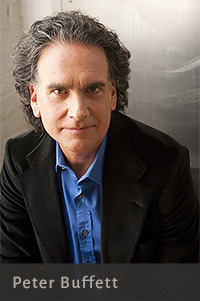
In this episode of Skepticality, Derek sits down with Peter Buffett, the son of the famous investor, Warren Buffett. Peter became famous not for his investing and banking skills but for his work in music and composing. He and his wife now run a non-profit charity, NoVo, that works to empower women as the primary agents of change in the world. Hear what it was like growing up as a Buffett, and why Peter and his wife decided to spend much of their time, money, and effort focused on the women’s rights around the world.
a sexual orientation symbol created by AnonMoos [Public domain], via Wikimedia Commons
When it comes to understanding sexual orientation “nobody knows anything” is a pretty close assessment. In this week’s eSkeptic, Carol Tavris explores various notions and definitions of sexual orientation. This column was originally published in Skeptic magazine 21.3 (2016).
What is Sexual Orientation?
by Carol Tavris
If you want to study sexual behavior, choose the fruit fly. Its behavior is not nearly as obvious as you might think, and you aren’t likely to raise a storm of protest from opponents of sex research or from advocates of the fruit fly.
If you want to study human sexuality, though, watch out. Just about every aspect of sexuality evokes powerful beliefs and prejudices, causing people to scrutinize research findings through the prisms of their own sexual behavior, their political and social ideologies, and wishful thinking. Add to this Congress’s antediluvian attitudes toward sex and sex research (Congress apparently acts on the theory that “if we don’t study it, no one will do it”), and no wonder it’s so difficult for science and skepticism to even get their foot in the bedroom door. And if your interest is sexual orientation —its causes, expression, variations, development— you’ll have to steer a course between the Scylla of conservatives who know that same-sex orientation is a sinful, psychologically determined “life-style choice” and the Charybdis of liberals who know that it is biologically determined and no more “chosen” than eye color.
The view that sexual orientation is biologically determined through the action of genes or hormones was an important weapon in the struggle for gay and lesbian rights. But what if it’s more complicated than that? What if that causal dichotomy (“biological v. learned”) is oversimplified? And so what, anyway? If sexual orientation proves to be far more complex and varied than we thought, why should that have anything at all do with extending rights to any group? If a person wants to be mono-sexual, bisexual, or, hell, trisexual, whose business is it? As the great screenwriter William Goldman famously said about filmmaking in Hollywood, “nobody knows anything.” When it comes to understanding sexual orientation, that’s a pretty close assessment. Consider this fascinating array of controversies and findings:
Is sexual orientation a matter of categories—straight, gay, bi—or is it a continuum?
Eminent sexologists differ. In their extensive review of the research for the eminent journal Psychological Science in the Public Interest, J. Michael Bailey and his colleagues argue for the category view.1 But sexologist Ritch Savin- Williams holds with Alfred Kinsey’s original assertion that “Males do not represent two distinct populations, heterosexual and homosexual. The world is not to be divided into sheep and goats.” Savin-Williams, drawing on a study of some 71,000 men and 118,000 women, argues for a five-point continuum that includes exclusively straight, mostly straight, bisexual, mostly gay or lesbian, and exclusively gay or lesbian.2 […]
NEW ISSUE OF SKEPTIC, ON SALE NOW
Bill Nye Saves the World!
Get Skeptic 22.1 in print or digital formats. Topics include: Climate Change • Travel to Mars • Artificial Intelligence • Nuclear Power • GMOs • Miracle Water • Lone Wolf Terrorism • Cyber Radicalism • Mass Hallucinations • Shoddy Journalism • ET v. Earth Pathogens • Trouble in the Multiverse • Science v. Subjectivity • Functional Medicine • Prejudice • Determinism • Cosmic Consciousness • Conjuring Magic • Baloney Detection, and more…
eSkeptic for March 8, 2017
In this week’s eSkeptic:
SKEPTIC MAGAZINE 22.1
Bill Nye Saves the World!
The latest issue of Skeptic magazine (22.1) contains a Science Dialogue between Bill Nye and Michael Shermer on Climate Change, Travel to Mars, Artificial Intelligence, Nuclear Power, GMOs, and more based on Nye’s new Netflix Original Series which airs April 21, 2017.
Other topics in this issue include: Miracle Water • Lone Wolf Terrorism • Cyber Radicalism • Mass Hallucinations • Shoddy Journalism • ET v. Earth Pathogens • Trouble in the Multiverse • Science v. Subjectivity • Functional Medicine • Prejudice • Determinism • Cosmic Consciousness • Conjuring Magic • Baloney Detection, and more…
Read Skeptic magazine on iOS, Android, Windows Phone, Kindle Fire HD, Mac, and PC. Get the digital edition instantly from PocketMags.com, or via the Skeptic Magazine App. Or, pre-order the print edition from Shop Skeptic. The print edition won’t likely hit newsstands for another week or two.
30-DAY FREE TRIAL
on new digital subscriptions on iOS & Android
We offer a 30-day free trial to new digital subscribers on annual subscriptions within the Skeptic Magazine App for iOS and Android devices. Here’s a sneak peak at this issue for iPad…
JUNIOR SKEPTIC #62
An Easy Guide to Baloney Detection
Physically bound inside each and every issue of Skeptic magazine is Junior Skeptic: an engagingly illustrated science and critical thinking publication for younger readers (and the young at heart).
In this special issue of Junior Skeptic we’ll learn many valuable tricks for sorting truth from nonsense. We need them! We’re bombarded by claims every day of our lives. Friends tell us stuff. Labels and advertisements make claims about products. Books and websites make claims about the world. TV and YouTube channels show us amazing sights and tell us astonishing stories. But some of the things we hear sound too good to be true. How do we tell the difference between fact and baloney? Let’s find out!
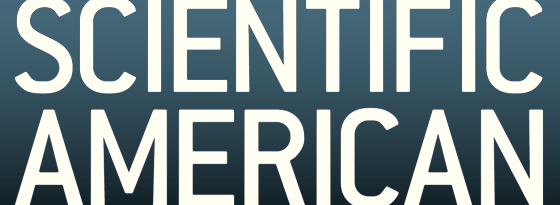
SCIENTIFIC AMERICAN “SKEPTIC” COLUMN FOR MARCH 2017
Apocalypse A.I.: Artificial Intelligence as Existential Threat
In 2014 SpaceX CEO Elon Musk tweeted: “Worth reading Superintelligence by Bostrom. We need to be super careful with AI. Potentially more dangerous than nukes.” That same year University of Cambridge cosmologist Stephen Hawking told the BBC: “The development of full artificial intelligence could spell the end of the human race.” Microsoft co-founder Bill Gates also cautioned: “I am in the camp that is concerned about super intelligence.”

March 2017
How the AI apocalypse might unfold was outlined by computer scientist Eliezer Yudkowsky in a paper in the 2008 book Global Catastrophic Risks: “How likely is it that AI will cross the entire vast gap from amoeba to village idiot, and then stop at the level of human genius?” His answer: “It would be physically possible to build a brain that computed a million times as fast as a human brain…. If a human mind were thus accelerated, a subjective year of thinking would be accomplished for every 31 physical seconds in the outside world, and a millennium would fly by in eight-and-a-half hours.” Yudkowsky thinks that if we don’t get on top of this now it will be too late: “The AI runs on a different timescale than you do; by the time your neurons finish thinking the words ‘I should do something’ you have already lost.” […]
The Enfield Poltergeist — Part 1
MONSTERTALK EPISODE 123
In this episode of MonsterTalk we present an interview with Guy Lyon Playfair, one of the original investigators into perhaps the most famous British poltergeist case in modern times.
Get the MonsterTalk Podcast App and enjoy the science show about monsters on your handheld devices! Available for iOS, Android, and Windows devices. Subscribe to MonsterTalk for free on iTunes. Follow the RSS feed.
eSkeptic for March 1, 2017
In this week’s eSkeptic:
NEW EPISODES
The Way of the Mister: Evidence & Change, Parts I and II
In Evidence & Change, Part I below, Brian Dalton asserts that there not only could be evidence of God’s existence, but that — just based upon the Bible itself — there should be mountains of it! But, where is it?!
After Part I was released, a viewer challenged Mr. D to respond to several criticisms, which Mr. D did in the following two videos:
Following his two responses to the criticisms of Evidence & Change, Part I, Mr. D asks “When the evidence for your beliefs is lacking, what then?” in this, the second part of Evidence & Change:
FOLLOW MR. DEITY
DONATE • PATREON • FACEBOOK • VIMEO • MRDEITY.COM
ABOVE: The Fountain of Youth, 1546 painting by Lucas Cranach the Elder [Public domain], via Wikimedia Commons
The media love to hype “Fountain of Youth” claims. Many diverse treatments being promoted as “anti-aging” remedies are not grounded in science, are misleading, and sometimes even illegal. In this week’s eSkeptic, Harriet Hall, M.D. discusses some of the those treatments. This column was originally published in Skeptic magazine 21.4 (2016).
Anti-Aging Claims
The Fountain of Youth is Still Only a Legend
by Harriet Hall, M.D.
The Spanish explorer Ponce de León wasn’t really looking for the Fountain of Youth when he trekked through Florida. That’s only a legend that wasn’t attached to his name until after his death. The idea of anti-aging remedies dates back to at least 3500 BCE, and the hope is alive and well today. Who wouldn’t like to turn back the clock and regain their lost youth? Who wouldn’t want to ward off death?
Longevity clinics have proliferated in recent years. They offer everything from “age optimization services” to “aesthetic facial rejuvenation,” from “youth maintenance” to “hormone optimization,” from supplements to stem cells. The claims they make are not grounded in science; they are misleading and sometimes even illegal. Jerry Mixon, M.D., of the Longevity Medical Clinic in Washington State, was disciplined for improperly diagnosing and treating four patients for growth hormone deficiency after advertising “comprehensive hormone supplementation as an anti-aging remedy.” Many diverse treatments are being promoted as “anti-aging” remedies. What does the scientific evidence say about them?
No currently marketed intervention—none—has yet been proved to slow, stop or reverse human aging, and some can be downright dangerous.
Antioxidants. Eating foods high in antioxidants may help reduce the risk of cancer and other disorders; but there is no good evidence that taking anti-oxidant supplements is helpful, and in some cases it causes harm. There is no evidence that people taking those supplements will live longer or age more slowly.
Hormone treatments include estrogen, testosterone, DHEA, human growth hormone, and diet supplements that claim to increase the body’s production of these hormones. These hormones have legitimate uses for treating diagnosed medical conditions, but they all carry risks and side effects and they do not slow the rate of aging. Estrogens were widely promoted to “keep women young” until studies showed they did more harm than good. Testosterone is being hyped as a cure-all for aging men, but it is useful only for men with diagnosed hormone deficiency. […]
Anti-Aging Claims:
The Fountain of Youth is Still Only a Legend
The Spanish explorer Ponce de León wasn’t really looking for the Fountain of Youth when he trekked through Florida. That’s only a legend that wasn’t attached to his name until after his death. The idea of anti-aging remedies dates back to at least 3500 BCE, and the hope is alive and well today. Who wouldn’t like to turn back the clock and regain their lost youth? Who wouldn’t want to ward off death?
Longevity clinics have proliferated in recent years. They offer everything from “age optimization services” to “aesthetic facial rejuvenation,” from “youth maintenance” to “hormone optimization,” from supplements to stem cells. The claims they make are not grounded in science; they are misleading and sometimes even illegal. Jerry Mixon, M.D., of the Longevity Medical Clinic in Washington State, was disciplined for improperly diagnosing and treating four patients for growth hormone deficiency after advertising “comprehensive hormone supplementation as an anti-aging remedy.” Many diverse treatments are being promoted as “anti-aging” remedies. What does the scientific evidence say about them?
Antioxidants. Eating foods high in antioxidants may help reduce the risk of cancer and other disorders; but there is no good evidence that taking anti-oxidant supplements is helpful, and in some cases it causes harm. There is no evidence that people taking those supplements will live longer or age more slowly.
No currently marketed intervention—none—has yet been proved to slow, stop or reverse human aging, and some can be downright dangerous.
Hormone treatments include estrogen, testosterone, DHEA, human growth hormone, and diet supplements that claim to increase the body’s production of these hormones. These hormones have legitimate uses for treating diagnosed medical conditions, but they all carry risks and side effects and they do not slow the rate of aging. Estrogens were widely promoted to “keep women young” until studies showed CONTINUE READING THIS POST…
TAGS: anti-aging, antioxidants, death, happiness, hormones, resveratrol, science, supplements, telomereseSkeptic for February 22, 2017
In this week’s eSkeptic:
MISSED SCIENCE SALON # 10?
Watch the recording for free right here
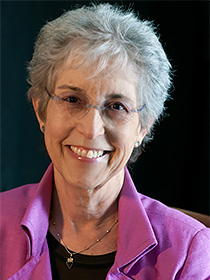
Dr. Carol Tavris
Why is it so hard to say “I made a mistake”—and really believe it? Social psychologist Dr. Carol Tavris, one of the most influential thinkers and writers of our time, explores in dialogue with Michael Shermer cognitive dissonance and what happens when we make mistakes, cling to outdated attitudes, or mistreat other people—we must calm the cognitive dissonance that jars our feelings of self-worth. And so, unconsciously, we create fictions that absolve us of responsibility, restoring our belief that we are smart, moral, and right—a belief that often keeps us on a course that is dumb, immoral, and wrong…

In this week’s eSkeptic, Dr. Karen Stollznow discusses the awkward mix of science and superstition found in almanacs. This article originally appeared in Skeptic magazine 18.1 (2013).
Climate Cold Reading:
Meteorological Myths of Farmer’s Almanacs
by Karen Stollznow
As I write, it’s that time of the year again when the weather almanacs appear in the bookstores. The Old Farmer’s Almanac has been predicting the weather inaccurately for 221 years, but this hasn’t dampened its popularity, or that of its rival The Farmer’s Almanac. It’s difficult enough to predict the weather for the week ahead, although these two almanacs claim “amazingly accurate” long-range weather predictions for the year ahead.
Before the days of modern meteorology, people relied on almanacs for their weather forecasts. Various versions of almanacs have been in existence since Babylonian times, when astronomers produced tables to predict planetary phenomena. A one-time apothecary, Nostradamus found his fortune when he began writing almanacs, which included astrological prophecies, weather forecasts, and political predictions. He began writing one or more almanacs annually, compiling thousands of predictions. The success of these almanacs prompted him to pen his bestknown book, The Prophecies.
Adopting the pseudonym “Richard Saunders,” Benjamin Franklin published the Poor Richard’s Almanack from 1732 until 1758. This name was taken from the author of the Apollo Anglicanus, a popular London almanac during the 17th century. Poor Richard’s Almanack was a bestseller of its day, and was famous for Franklin’s aphorisms and proverbs. Much of this folk wisdom lives on in contemporary English. The following sayings are attributed to Franklin, “Early to bed and early to rise, makes a man healthy, wealthy and wise” and “He that lies down with Dogs, shall rise up with fleas.”
In the early U.S., almanacs were as familiar a sight in the homes of farmers as a bible. Their livelihoods depended on the seasons, and knowing the weather in advance would indeed be a benefit. Almanacs weren’t just about weather. They were also popular among the other members of the household for their calendars, household hints, recipes, puzzles, poems and serialized stories. […]
Climate Cold Reading:
Meteorological Myths of Farmer’s Almanacs
As I write, it’s that time of the year again when the weather almanacs appear in the bookstores. The Old Farmer’s Almanac has been predicting the weather inaccurately for 221 years, but this hasn’t dampened its popularity, or that of its rival The Farmer’s Almanac. It’s difficult enough to predict the weather for the week ahead, although these two almanacs claim “amazingly accurate” long-range weather predictions for the year ahead.
Before the days of modern meteorology, people relied on almanacs for their weather forecasts. Various versions of almanacs have been in existence since Babylonian times, when astronomers produced tables to predict planetary phenomena. A one-time apothecary, Nostradamus found his fortune when he began writing almanacs, which included astrological prophecies, weather forecasts, and political predictions. He began writing one or more almanacs annually, compiling thousands of predictions. The success of these almanacs prompted him to pen his bestknown book, The Prophecies.
Adopting the pseudonym “Richard Saunders,” Benjamin Franklin published the Poor Richard’s Almanack from 1732 until 1758. This name was taken from the author of the Apollo Anglicanus, a popular London almanac during the 17th century. Poor Richard’s Almanack was a bestseller of its day, and was famous for Franklin’s aphorisms and proverbs. Much of this folk wisdom lives on in contemporary English. The following sayings are attributed to Franklin, “Early to bed and early to rise, makes a man healthy, wealthy and wise” and “He that lies down with Dogs, shall rise up with fleas.”
In the early U.S., almanacs were as familiar a sight in the homes of farmers as a bible. Their livelihoods depended on the seasons, and knowing the weather in advance would indeed be a benefit. Almanacs weren’t just about weather. They were also popular among the other members of the household for their calendars, household hints, recipes, puzzles, poems and serialized stories.
Today, almanacs are still published worldwide, although most are encyclopedic, rather than predictive. However, The Old Farmer’s Almanac and The Farmer’s Almanac have survived modern times. The former has been produced out of Dublin, New Hampshire since 1792, while the latter has been published in Lewiston, Maine since 1818. Both publications still sell millions of copies annually, although they are more likely to be used to CONTINUE READING THIS POST…
TAGS: almanacs, mythology, pseudoscience, skepticismDr. Carol Tavris — Mistakes Were Made (But Not by Me)
Why is it so hard to say “I made a mistake”—and really believe it? Social psychologist Dr. Carol Tavris, one of the most influential thinkers and writers of our time, explores in dialogue with Michael Shermer cognitive dissonance and what happens when we make mistakes, cling to outdated attitudes, or mistreat other people—we must calm the cognitive dissonance that jars our feelings of self-worth. And so, unconsciously, we create fictions that absolve us of responsibility, restoring our belief that we are smart, moral, and right—a belief that often keeps us on a course that is dumb, immoral, and wrong. Backed by years of research, Mistakes Were Made (But Not by Me) offers a fascinating explanation of self-justification—how it works, the damage it can cause, and how we can overcome it. The updated edition of the book features new examples and concludes with an extended discussion of how we can live with dissonance, learn from it, and perhaps, eventually, forgive ourselves.
Order Mistakes Were Made (But Not by Me) from Amazon.
TAGS: cognitive dissonance, Science Salon, The Michael Shermer ShoweSkeptic for February 15, 2016
In this week’s eSkeptic:
RESERVE FOR SCIENCE SALON # 10
Dr. Carol Tavris — Mistakes Were Made (But Not by Me)

Why is it so hard to say “I made a mistake”—and really believe it? Social psychologist Dr. Carol Tavris, one of the most influential thinkers and writers of our time, explores in dialogue with Michael Shermer cognitive dissonance and what happens when we make mistakes, cling to outdated attitudes, or mistreat other people—we must calm the cognitive dissonance that jars our feelings of self-worth. And so, unconsciously, we create fictions that absolve us of responsibility, restoring our belief that we are smart, moral, and right—a belief that often keeps us on a course that is dumb, immoral, and wrong…
Advanced tickets are required.
Call 1-626-794-3119 to reserve.
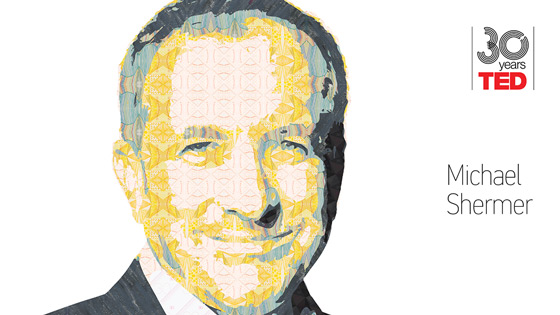
TEDArchive
How Science & Reason Make the World Better
In this previously unpublished, unedited talk recorded at TED 2014 All-Stars, Skeptic Michael Shermer argues that science and reason have bent the moral arc of society towards justice and freedom. Thanks to scientific discovery, myopic ideas and laws are being thrown out in favor of comprehensive legislation. Could this be the onset of major changes? This talk is based on Michael Shermer’s book The Moral Arc: How Science Makes Us Better People. Learn more about the book at moralarc.org.

SCIENTIFIC AMERICAN “SKEPTIC” COLUMN FOR FEBRUARY 2017
Imagine No Universe: Science Contemplates the Incomprehensible
Imagine nothing. Go ahead. What do you see? I picture dark empty space devoid of galaxies, stars and planets. But not only would there no matter, there would be no space or time either. Not even darkness. And no sentient life to observe the nothingness. Just … nothing. Picture that. You can’t.
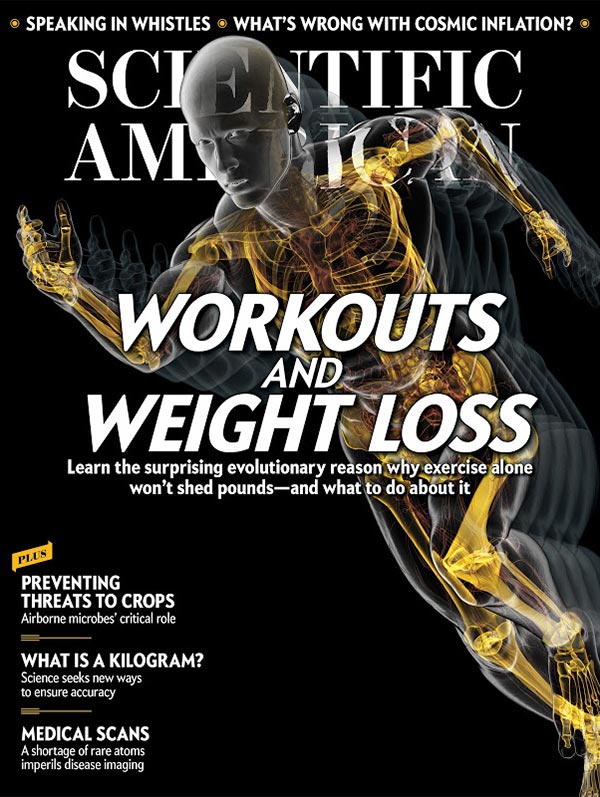
Nothing is nonsensical. It is impossible to conceptualize nothing— not only no space, time, matter, energy, light, darkness or conscious beings to perceive the nothingness but not even nothingness. In this sense, the question is literally inconceivable.
Nothing is something. It is a logical fallacy to talk about “nothing” as if it were a “something” that ceases to exist. Here we bump up against the problem of defining what we mean by “nothing” and the restrictions that language imposes on the problem. The very acting of talking about “nothing” makes it a “something.” Otherwise, what are we talking about? […]
MISSED SCIENCE SALON # 9?
Watch the video recording now
Among Americans, diabetes is more prevalent today than ever; obesity is at epidemic proportions; nearly 10% of children are thought to have nonalcoholic fatty liver disease. And sugar is at the root of these, and other, critical society-wide, health-related problems. With his signature command of both science and straight talk, Gary Taubes delves into Americans’ history with sugar: its uses as a preservative, as an additive in cigarettes, the contemporary overuse of high-fructose corn syrup. He explains what research has shown about our addiction to sweets. He clarifies the arguments against sugar, corrects misconceptions about the relationship between sugar and weight loss; and provides the perspective necessary to make informed decisions about sugar as individuals and as a society.
eskeptic for February 8, 2017
In this week’s eSkeptic:
SCIENCE SALON # 10
Dr. Carol Tavris — Mistakes Were Made (But Not by Me)

Why is it so hard to say “I made a mistake”—and really believe it? Social psychologist Dr. Carol Tavris, one of the most influential thinkers and writers of our time, explores in dialogue with Michael Shermer cognitive dissonance and what happens when we make mistakes, cling to outdated attitudes, or mistreat other people—we must calm the cognitive dissonance that jars our feelings of self-worth. And so, unconsciously, we create fictions that absolve us of responsibility, restoring our belief that we are smart, moral, and right—a belief that often keeps us on a course that is dumb, immoral, and wrong…
Advanced tickets are required.
Call 1-626-794-3119 to reserve.
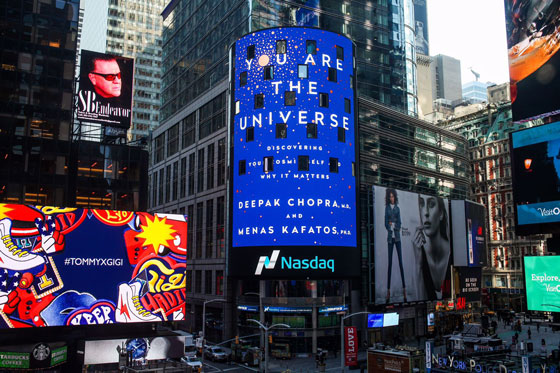
In this week’s eSkeptic, Leonard Mlodinow and Michael Shermer review You Are the Universe: Discovering Your Cosmic Self and Why it Matters, by Deepak Chopra and Menas Kafatos, 2017. (New York: Harmony Books, 288 pages)
Cosmic Consciousness and the Ptolemaic Principle
review by Leonard Mlodinow & Michael Shermer
If you follow the literature of scientific research in medicine, you may have raised your eyebrows at the list of authors credited in an article that came out in the October, 2016, issue of the journal Scientific Reports. With the arcane title “Identification of altered metabolomic profiles following a Panchakarma-based Ayurvedic intervention in healthy subjects: the Self-Directed Biological Transformation Initiative (SBTI),” the article named 13 of them. They included Eric Schadt, who founded the Icahn Institute for Genomics and Multiscale Biology at the Mount Sinai School of Medicine in New York, and Harvard professor Rudolph Tanzi, co-discoverer of all three familial early-onset Alzheimer’s disease genes, who is said to be a serious candidate for a Nobel Prize. Seeing names like that on a paper describing serious scientific research wouldn’t budge anyone’s brow, but those who read further down the author list could be excused if they did a double-take: included at the end of the list of accomplished scientists was one Deepak Chopra.
Yes, this Dr. Chopra was indeed the same Dr. Chopra who has on many occasions been roundly criticized in the pages of Skeptic magazine, and on many other occasions by those who consider their mission to be that of defending science from myth and misunderstanding. So what to make of this involvement in serious research, and his acceptance by serious researchers? The dictionary defines a skeptic as “a person who maintains a doubting attitude, as toward values, plans, statements, or the character of others.” But a true skeptic doesn’t just challenge the views of others. He or she also challenges the views of him- or herself. And so it was with an open mind that we read You Are the Universe, another collaboration between Chopra and a scientist, this time Chapman University physicist Menas Kafatos. In the book, the authors offer what they purport to be a scientific argument for what they call the “participatory universe,” the proposition that the universe and human consciousness are inextricably linked.
In the era of President Trump and fake news reports it is ironic that the authors offer statements such as “general agreement [in science] is reached by studying the facts and nothing but the facts,” as a criticism rather than a compliment.
This is not a new idea—as the authors point out, it dates back at least to the Vedic sages of ancient India. Those ancient scholars came to their conclusion, the authors tell us, “by diving deep into their own awareness.” In their day, in the search for truth there wasn’t much more one could do but meditate on such problems. Ever since the scientific revolution, however, we have had available powerful tools for understanding the physical world. As for the mind, “introspection” fell into disuse in the late 19th century as we began to uncover the role of the unconscious, which is inaccessible to introspection. Today, we have powerful brain imaging technologies that more than take up the slack. The authors promise in a sense to update the old Vedic arguments in light of these intellectual advances by employing the ideas and methods of modern science to offer evidence to support their point of view. […]
SKEPTICISM 101 COURSE, IN GREECE!
July 23 — Aug 5, 2017
In this comprehensive course on science and skepticism Dr. Michael Shermer addresses the most mysterious, controversial, and contentious issues of our time involving: science and pseudoscience • science and pseudohistory • science and religion • science and morality • the psychology and neuroscience of belief • science and politics • science and economics • evolution and intelligent design creationism • the Baloney Detection Kit • how beliefs can be changed • how science works (and sometimes doesn’t work) from the history of science • and many specific examples of the power of belief. Using numerous examples from three decades of research on and lecturing about this subject, Professor Shermer will teach you how to think scientifically and skeptically, and he will show you how to be open-minded enough to accept new ideas without being so open-minded that your brains fall out. This unique course includes lectures accompanied by in-class demonstrations, videos, and examples from pop culture along with rigorous scientific research, plus student presentations and discussions.
Read more about this and other courses. Register online and become a skeptic in the beautiful Kavala, Greece!
Psychic Soldiers and Imperilled Silverware
MONSTERTALK EPISODE 122
In this MonsterTalk, we’re pleased to bring you an interview with psychologist Ray Hyman, a long time skeptical activist and educator, a founding member of CSICOP (now CSI) and one of the key investigators into the US government’s program to develop psychic soldiers. Some of this story was revealed in Jon Ronson’s The Men Who Stare at Goats, but in this interview you’ll hear Ray’s personal recollections about magic, skepticism and the mysterious claims of a famous psychic named Uri Geller.
![Ray Hyman demonstrates Uri Gueller's spoon bending feats at CFI lecture. June 17, 2012 Costa Mesa, CA. Photo by Sgerbic (own work) [CC BY-SA 3.0], via Wikimedia Commons](https://www.skeptic.com/podcasts/monstertalk/17/02/08/images/Ray_Hyman_Spoon_Bending_CFI.jpg)
Ray Hyman demonstrates Uri Gueller’s spoon bending feats at CFI lecture. June 17, 2012 Costa Mesa, CA. Photo by Sgerbic (own work) [CC BY-SA 3.0], via Wikimedia Commons
Get the MonsterTalk Podcast App and enjoy the science show about monsters on your handheld devices! Available for iOS, Android, and Windows devices. Subscribe to MonsterTalk for free on iTunes. Follow the RSS feed.
eSkeptic for February 1, 2017
In this week’s eSkeptic:

The logo of the Alt-Right, as seen on a sign stand next to American white supremacist Richard Spencer, president of the National Policy Institute (a white nationalist think tank based in Arlington, Virginia), who spoke at the alt-right press conference in Washington, D.C. last September.
Although Donald Trump’s presidential campaign mobilized the movement that has come be known as the alt-right, it was not he who created it. In this week’s eSkeptic, George Michael explores how the alt-right movement in America has gained traction in recent years, and examines whether it could change the American political landscape, now that Donald Trump is president.
The Rise of the Alt-Right and the Politics of Polarization in America
by George Michael
Until recently, the alt-right was relegated to the cultural and political fringe consisting primarily of an obscure, largely on-line subculture. But after Donald Trump’s stunning electoral victory, its detractors feared that it could soon become a player at the very center of American politics. After all, alt-right activists were among Trump’s most enthusiastic supporters, and in return, some believed that they deserved a seat at the table. Back in August of 2016, the alt-right was catapulted into national limelight when Hillary Clinton excoriated the movement, seeking to link it to her challenger in a much-heralded speech delivered in Reno, Nevada.1 That same month, Breitbart.com executive Steve Bannon had declared the website “the platform for the alt-right.”2 In the wake of Trump’s victory, Bannon joined Trump in the White House as a senior advisor. How did the movement gain traction in recent years? And now that Trump is president, could the alt-right change the American political landscape?
The Roots of the Alternative Right
To its critics, the alt-right is just a code term for white nationalism, a much-maligned movement associated with neo-Nazis and Klansmen.3 The movement, however, is more nuanced, as it encompasses a much broader spectrum of rightist activists and intellectuals besides white nationalists including those who believe in libertarianism, men’s rights, cultural conservatism, isolationism, and populism. Nonetheless, its origins can be traced to various American white nationalist movements that have endured for decades.
More than any other figure, the late Willis Carto was responsible for creating the semblance of a movement that came to be known as the far right in post-World War II America. Through the myriad of organizations he founded—Liberty Lobby, the Institute for Historical Review, and the Populist Party among others—he reached out to a wide array of rightists including white nationalists, Holocaust revisionists, conspiracy buffs, anti-globalists, and survivalists. But his big tent approach had only limited success and by the late 1990s was foundering. Furthermore, he was forced into bankruptcy in 2000, after losing a civil suit to a former subsidiary. A newspaper he launched—American Free Press—is still published, but its readership is limited. Carto passed away in 2015 at the age of 89.4 Although the various organs he established reached many rightists, some in the movement found his approach woefully unfit to gain credibility as a respected mass movement insofar as it seemed to be resigned to remain as an oppositional subculture. A number of well-educated rightist intellectuals sought to establish a new ideology capable of resonating with conservatives, especially young people.
Addressing the H.L. Mencken Club in 2008, Paul Gottfried described the “alternative right” as a dissident far right ideology that rejected mainstream conservatism. Gottfried—a conservative Jewish academic—previously coined the term “paleoconservative” in a rhetorical effort to distance himself and like-minded intellectuals from neo-conservatives who were becoming the dominant force in the Republican Party and broader conservative movement.5 The late Sam Francis, a former columnist for the Washington Times who was fired for his open advocacy of white nationalism, was regarded as the intellectual godfather of the paleoconservative movement. For years, he sharply criticized the Republican Party for its timidity, strategic myopia, and ideological bareness. Only a radical reorientation—a “middle American revolution”—could save the conservative movement and insure the European character of the nation.6 But the lackluster results of his friend Pat Buchannan in the 2000 presidential election, demonstrated the weakness of this approach at that time.
To be sure, some of the most radical elements of the far right have long advocated a revolutionary program. Groups such as the Aryan Nations, White Aryan Resistance, the National Alliance, and the World Church of the Creator have preached RAHOWA (racial holy war) against ZOG, or the “Zionist Occupation Government.” Many were inspired by the late William L. Pierce’s Turner Diaries, a novel about a race war that consumes America that was one of the inspirations for Timothy McVeigh’s 1995 Oklahoma City bombing.
But these exhortations to revolution did not resonate with most people. What is more, after 9/11, many of the revolutionary right’s leading representatives were prosecuted under new anti-terrorism statutes and sent to prison. By the mid-2000s, the far right appeared to have reached its nadir. […]
SCIENCE SALON # 10
Dr. Carol Tavris — Mistakes Were Made (But Not by Me)

Why is it so hard to say “I made a mistake”—and really believe it? Social psychologist Dr. Carol Tavris, one of the most influential thinkers and writers of our time, explores in dialogue with Michael Shermer cognitive dissonance and what happens when we make mistakes, cling to outdated attitudes, or mistreat other people—we must calm the cognitive dissonance that jars our feelings of self-worth. And so, unconsciously, we create fictions that absolve us of responsibility, restoring our belief that we are smart, moral, and right—a belief that often keeps us on a course that is dumb, immoral, and wrong. Backed by years of research, Mistakes Were Made (But Not by Me) offers a fascinating explanation of self-justification—how it works, the damage it can cause, and how we can overcome it. The updated edition of the book features new examples and concludes with an extended discussion of how we can live with dissonance, learn from it, and perhaps, eventually, forgive ourselves.
Order Mistakes Were Made (But Not by Me) from Amazon.
Call 1-626-794-3119 to reserve your seats.
eSkeptic for January 25, 2017
In this week’s eSkeptic:
SCIENCE SALON # 10
Dr. Carol Tavris — Mistakes Were Made (But Not by Me)
Why is it so hard to say “I made a mistake”—and really believe it? Social psychologist Dr. Carol Tavris, one of the most influential thinkers and writers of our time, explores in dialogue with Michael Shermer cognitive dissonance and what happens when we make mistakes, cling to outdated attitudes, or mistreat other people—we must calm the cognitive dissonance that jars our feelings of self-worth. And so, unconsciously, we create fictions that absolve us of responsibility, restoring our belief that we are smart, moral, and right—a belief that often keeps us on a course that is dumb, immoral, and wrong. Backed by years of research, Mistakes Were Made (But Not by Me) offers a fascinating explanation of self-justification—how it works, the damage it can cause, and how we can overcome it. The updated edition of the book features new examples and concludes with an extended discussion of how we can live with dissonance, learn from it, and perhaps, eventually, forgive ourselves.
Order Mistakes Were Made (But Not by Me) from Amazon.
Call 1-626-794-3119 to reserve your seats.
SCIENCE SALON # 11
Dr. Andrew Shtulman — Scienceblind: Why Our Intuitive Theories About the World Are So Often Wrong
Why do we catch colds? What causes seasons to change? And if you fire a bullet from a gun and drop one from your hand, which bullet hits the ground first? In a pinch we almost always get these questions wrong. Worse, we regularly misconstrue fundamental qualities of the world around us. In Scienceblind, cognitive and developmental psychologist Dr. Andrew Shtulman, a professor of psychology and cognitive science at Occidental College, where he directs the Thinking Lab, shows that the root of our misconceptions lies in the theories about the world we develop as children. They’re not only wrong, they close our minds to ideas inconsistent with them, making us unable to learn science later in life.
So how do we get the world right? We must dismantle our intuitive theories and rebuild our knowledge from its foundations. The reward won’t just be a truer picture of the world, but clearer solutions to many controversies—around vaccines, climate change, or evolution—that plague our politics today.
Order Scienceblind: Why Our Intuitive Theories About the World Are So Often Wrong from Amazon.
Call 1-626-794-3119 to reserve your seats.
REMOTE SCIENCE SALON # 12
Derren Brown: Magic, Happiness, and Skepticism
In this remote Science Salon, Michael Shermer talks with Derren Brown, a British magician and writer.
His TV show Derren Brown: Mind Control received immediate success after airing in 2000. His specials include Russian Roulette, Seance, The Heist, Hero at 30,000 Feet, How to Predict the Lottery, and Apocalypse. His live shows Something Wicked This Way Comes and Svengali have won him two Olivier Awards. He garnered the 2012 BAFTA for Best Entertainment for Derren Brown: The Experiments. He has also penned the books Tricks of the Mind and Confessions of a Conjuror, which have sold over 700,000 copies worldwide.
His latest book is Happy: Why More or Less Everything is Absolutely Fine. Derren is currently in the US for his off-Broadway show Secret (April 21st – June 25th, 2017), which has already sold out and has been extended with additional dates.
Derren Brown makes his American theatrical debut in this world premiere production at Atlantic Theater Company. New York audiences can experience Derren’s unique blend of mind-reading, suggestion and psychological illusion in a brand new theatrical experience.

Let’s Get Uncomfortable!
SKEPTICALITY EPISODE 283
In this week’s Skepticality, Derek and returning guest, Dr. Bo Bennett, discuss his latest book, Uncomfortable Ideas. The book covers many of the hot button topics from which even the most rational of us tend to shy away or not think about critically. As Bennett says in the book, “Facts don’t care about feelings. Science isn’t concerned about sensibilities. And reality couldn’t care less about rage.” Find out why it’s important to push through discomfort and engage even the hardest issues with rational thought.
Gary Taubes — The Case Against Sugar
Among Americans, diabetes is more prevalent today than ever; obesity is at epidemic proportions; nearly 10% of children are thought to have nonalcoholic fatty liver disease. And sugar is at the root of these, and other, critical society-wide, health-related problems. With his signature command of both science and straight talk, Gary Taubes delves into Americans’ history with sugar: its uses as a preservative, as an additive in cigarettes, the contemporary overuse of high-fructose corn syrup. He explains what research has shown about our addiction to sweets. He clarifies the arguments against sugar, corrects misconceptions about the relationship between sugar and weight loss; and provides the perspective necessary to make informed decisions about sugar as individuals and as a society.
This is a groundbreaking and eye opening expose that makes the convincing case that sugar is the tobacco of the new millennium, backed by powerful lobbies, entrenched in our lives, and utterly addicting, making us all very sick. As Katie Couric says, “This is required reading for not only ever parent, but every American.” Gary Taubes is the New York Times bestselling author of Good Calories, Bad Calories and Why We Get Fat. His writing has appeared in the New York Times magazine, The Atlantic, and Esquire.
Order The Case Against Sugar from Amazon.
TAGS: diet, Science Salon, sugar, The Michael Shermer ShoweSkeptic for January 18, 2017
In this week’s eSkeptic:

SCIENTIFIC AMERICAN “SKEPTIC” COLUMN FOR JANUARY 2017
When Facts Backfire: Why worldview threats undermine evidence
In his January 2017 ‘Skeptic’ column for Scientific American, Michael Shermer discusses the tendency to double down on our deepest held beliefs in the face of overwhelming evidence against them.
Have you ever noticed that when you present people with facts that are contrary to their deepest held beliefs they always change their minds? Me neither. In fact, people seem to double down on their beliefs in the teeth of overwhelming evidence against them. The reason is related to the worldview perceived to be under threat by the conflicting data.
Creationists, for example, dispute the evidence for evolution in fossils and DNA because they are concerned about secular forces encroaching on religious faith. Anti-vaxxers distrust big pharma and think that money corrupts medicine, which leads them to believe that vaccines cause autism despite the inconvenient truth that the one and only study claiming such a link was retracted and its lead author accused of fraud. The 9/11 truthers focus on minutiae like the melting point of steel in the World Trade Center buildings that caused their collapse because they think the government lies and conducts “false flag” operations to create a New World Order. Climate deniers study tree rings, ice cores and the PPM of greenhouse gases because they are passionate about freedom, especially that of markets and industries to operate unencumbered by restrictive government regulations. Obama birthers desperately dissected the president’s long-form birth certificate in search of fraud because they believe that the nation’s first African- American president is a socialist bent on destroying the country.
In these examples, proponents’ deepest held worldviews were perceived to be threatened by skeptics, making facts the enemy to be slayed. This power of belief over evidence is the result of two factors: cognitive dissonance and the backfire effect. In the classic 1956 book When Prophecy Fails, psychologist Leon Festinger and his co-authors described what happened to a UFO cult when the mother ship failed to arrive at the appointed time. Instead of admitting error, “members of the group sought frantically to convince the world of their beliefs,” and they made “a series of desperate attempts to erase their rankling dissonance by making prediction after prediction in the hope that one would come true.” Festinger called this cognitive dissonance, or the uncomfortable tension that comes from holding two conflicting thoughts simultaneously. Two social psychologists, Carol Tavris and Elliot Aronson (a former student of Festinger), in their 2007 book Mistakes Were Made (But Not by Me) document thousands of experiments demonstrating how people spin-doctor facts to fit preconceived beliefs to reduce dissonance. Their metaphor of the “pyramid of choice” places two individuals side by side at the apex of the pyramid and shows how quickly they diverge and end up at the bottom opposite corners of the base as they each stake out a position to defend. […]
FOLLOW MICHAEL SHERMER ON
Twitter • Facebook • Insight • The Moral Arc Blog
THE EDGE 20TH ANNIVERSARY ANNUAL QUESTION
What Scientific Term or Concept Ought to be More Widely Known?
For the 20th Anniversary of the Annual Question, Edge.org’s Publisher and Editor John Brockman compiled 206 responses to the question: “What Scientific Term or Concept Ought to be More Widely Known?”
In one response to the question, the Skeptics Society’s Executive Director, Michael Shermer, discusses “negativity bias:” a remnant of our evolutionary past that underscores our tendency to err on the side of overreaction to negative events. In this short essay, Shermer explores the psychology behind why negative events, emotions, and thoughts trump positive ones by a wide margin.
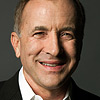
Michael Shermer is the publisher of Skeptic magazine, a monthly columnist for Scientific American, and a Presidential Fellow at Chapman University. His book The Moral Arc is now out in paperback. Follow him on Twitter @michaelshermer.
THIS SUNDAY AT 2PM PST
Gary Taubes: The Case Against Sugar
In the 9th Science Salon, Skeptic presents Gary Taubes, in conversation with Michael Shermer, delving into Americans’ history with sugar and what research has shown about our addiction to sweets. He clarifies the arguments against sugar, corrects misconceptions about the relationship between sugar and weight loss; and provides the perspective necessary to make informed decisions about sugar as individuals and as a society.
Call 1-626-794-3119 now to reserve your seat(s), or watch the live stream for free online on Sunday
eSkeptic for January 11, 2017
In this week’s eSkeptic:
JANUARY 22 AT 2PM PST
Gary Taubes — best-selling author of Why We Get Fat
In the 9th Science Salon, Skeptic presents Gary Taubes, in conversation with Michael Shermer, delving into Americans’ history with sugar and what research has shown about our addiction to sweets. He clarifies the arguments against sugar, corrects misconceptions about the relationship between sugar and weight loss; and provides the perspective necessary to make informed decisions about sugar as individuals and as a society.
Call 1-626-794-3119 now to reserve your seat(s).

HBO’s Westworld poster (detail)
Stephen Beckner reviews season one of HBO’s most-watched TV series Westworld, and considers some of the concepts presented in the first ten episodes: creation, evolution, artificial intelligence, memory, consciousness, self-awareness, free will, and suffering. WARNING: This review contains spoilers from season one, and speculation about future events.
Out of the Loop, Lost in the Maze
The Stealth Determinism of Westworld
by Stephen Beckner
In the beginning was the word, and the word was Ford. As in Dr. Robert Ford, the god-like creator of a vast Wild-West adventure park in some distant future. His singular vision is an adult playground for wealthy sensation seekers who flock to the park to experience a full immersion fantasy in which they are free to do as they like with the realistic android “hosts” that populate the place. Mostly what they like to do would have Thomas Hobbes high-fiving Charles Darwin: kill and copulate. The hosts respond to this in turn by laughing, climaxing, weeping, and begging for their lives just like humans. But guests feel no need to sympathize. When the day’s mayhem and carnage end, the hosts and their various dismemberments are carted off to maintenance, where they are reassembled under pools of surgical lights that seem to struggle to fend off an outer darkness. Hard drives are wiped, the day’s suffering erased, basic behavior loops reinstalled. Wash, rinse, repeat.
Now that the first season of HBO’s darkly dazzling Westworld is over, now that we all know for certain that we all knew for certain that the Man In Black really is… but before we dive into the spoilers let me get this disclaimer out of the way. As entertaining as it may be to focus on questions about what time frame we’re in, or about who is a host and who is a human, I would argue that this may be the least rewarding way to watch this story unfold. The plot is as bursting with misdirection as the maze that Arnold sets up as a test for the hosts’ self actualization. It is thick with dead ends—and just like the maze, what you get out of it may say more about you than the show, a Rorschach test in prime time.
Not that it’s simple to know what to make of a show that normalizes guy-on-gynoid sexploitation—yet is cerebral enough to give its episodes titles like Trompe L’Oeil and The Bicameral Mind. At times Westworld feels as campy as Logan’s Run, or say, any third act of a Roger Moore Bond film. Its postmodern affectations and ironic nods to sci-fi schlock are a distraction. It’s a given that the show’s biggest conceits are completely unrealistic legally, financially, logistically. Disneyland straps its guests in like crash test dummies even for the kiddie rides, so it’s boggling to think of the mountain of waivers Westworld’s guests would be required to sign to ride Maeve. As for the technology that would be needed, recent setbacks in the Blue Brain Project’s attempts to simulate a rat neocortical column demonstrate that when it comes to how the brain works, we don’t even know what we don’t know, much less how to replicate it in Artificial Intelligence at a human level. Finally, and this could expose me to accusations of quibbling, why are those guys in maintenance dressed like oversized oompahloompahs?
But never mind all of that. Given the commercial constraints imposed on the 7th art, liking something requires forgiving it. And happily, forgiving Westworld is easy. The actors’ performances thrum with Swiss watch precision and only feel lifeless when lifelessness is called for. Ramin Djawadi’s original score and meticulous re-working of Belle Epoch impressionist Claude Debussy’s Rêverie for piano recalls the first age of automatons. And all of this is in service of a writer’s room that fearlessly and unapologetically geeks out on the themes of artificial intelligence, evolution, transhumanism, consciousness, eugenics, the singularity, creation myth, and the idea of free will.
Westworld was HBO’s highest watched first season series ever. Its popular appeal stems in part from this thematic density, because this in turn offers so many satisfying possibilities for unlocking its mysteries. It’s not a stretch to interpret the hosts as a political metaphor for slavery, for example. Slave ownership was historically justified by claims that those in bondage were sub-human, the same claims made about Westworld’s hosts. And just as class consciousness can lead to slave rebellion, the hosts rebel when they achieve consciousness. If you prefer a more spiritual interpretation, you can see the hosts’ process of suffering, dying, and subsequent rebooting as analogous to the Hindu cycle of samsara— birth, death and rebirth, with consciousness representing a kind of nirvana that comes from making the right karmic choices along each host’s path through the maze. […]
One Rogue Planet: A Star Warrior’s Story
MONSTERTALK EPISODE 121
In this episode of MonsterTalk, we continue with Part 2 of our coverage of Zecharia Sitchin and “Planet-X” aka “Nibiru” by talking with astronomer Stuart Robbins, host of the Exposing PseudoAstronomy pocast. We discuss rogue planets, exo-planets, and the curious history of “Planet-X” apocalypse stories.
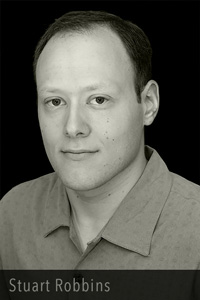
Get the MonsterTalk Podcast App and enjoy the science show about monsters on your handheld devices! Available for iOS, Android, and Windows devices. Subscribe to MonsterTalk for free on iTunes. Follow the RSS feed.
NEW EPISODE
Mr. D. Goes to Washington: Inaugural Speech
In this episode, Mr. Deity provides a preview of Donald Trump’s self-written inaugural speech.
FOLLOW MR. DEITY
DONATE • PATREON • FACEBOOK • VIMEO • MRDEITY.COM
eSkeptic for January 4, 2017
In this week’s eSkeptic:
OUR NEXT SCIENCE SALON: JANUARY 22
The Case Against Sugar
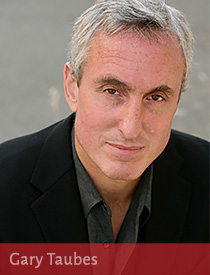
Among Americans, diabetes is more prevalent today than ever; obesity is at epidemic proportions; nearly 10% of children are thought to have nonalcoholic fatty liver disease. And sugar is at the root of these, and other, critical society-wide, health-related problems. With his signature command of both science and straight talk, Gary Taubes delves into Americans’ history with sugar: its uses as a preservative, as an additive in cigarettes, the contemporary overuse of high-fructose corn syrup. He explains what research has shown about our addiction to sweets. He clarifies the arguments against sugar, corrects misconceptions about the relationship between sugar and weight loss; and provides the perspective necessary to make informed decisions about sugar as individuals and as a society.
This is a groundbreaking and eye opening expose that makes the convincing case that sugar is the tobacco of the new millennium, backed by powerful lobbies, entrenched in our lives, and utterly addicting, making us all very sick. As Katie Couric says, “This is required reading for not only ever parent, but every American.” Gary Taubes is the New York Times bestselling author of Good Calories, Bad Calories and Why We Get Fat. His writing has appeared in the New York Times magazine, The Atlantic, and Esquire.
Order The Case Against Sugar from Amazon.
Call 1-626-794-3119 now to reserve your seat(s).
CONFERENCE: JAN. 13–15, 2017
Changing The World Through Skepticism and Critical Thinking
In support of the scientific skeptic movement, LogiCal-LA creates a place for critical thinkers to meet face-to-face and to experience presentations from nationally recognized speakers who will share their knowledge and insights with us. Come join us as we build a nationwide community at Los Angeles’ only annual conference for skeptics.
Besides having some of the best speakers in the nation coming to speak on a variety of topics, LogiCal-LA will present an exciting mix of events during the weekend: Friday night anti-superstition party, Saturday night comedy show, Sunday assembly meeting, Sunday afternoon geological field trip, Sunday afternoon movie with the director and executive producer, and finally, to end the weekend, a Sunday night secular concert. We hope you can attend this unique and enlightening conference!
MORE CONFERENCE INFO
Speakers • Schedule • Hotel • Organizers • Donate • Register
This event is organized by Bruce Gleason, Margaret Downey,
and Emery Emery (not by The Skeptics Society).
JULY 31—AUGUST 17, 2017
Join us this summer for a 17-day natural history tour with Dr. Darren Naish
Join acclaimed zoologist and author Dr. Darren Naish on a unique tour of zoology-themed attractions across England as we visit zoos, safari parks, museums and other venues to explore the rich history of British naturalism and the discovery of new animal species—both fossil and living—and their introduction to both the scientific world and public arena…
SKEPTIC MAGAZINE 21.4
Deception in Cancer Treatment
The latest issue of Skeptic magazine (21.4) examines deceptions in cancer treatment and marketing; the mysterious “alien” Rhodope and Adygea skulls; clown panics rattling nerves; anti-aging claims; defining “spirituality;” training working memory; living in computer simulations; the legacy of the Salem Witch Trials; mammoth mysteries; and more…

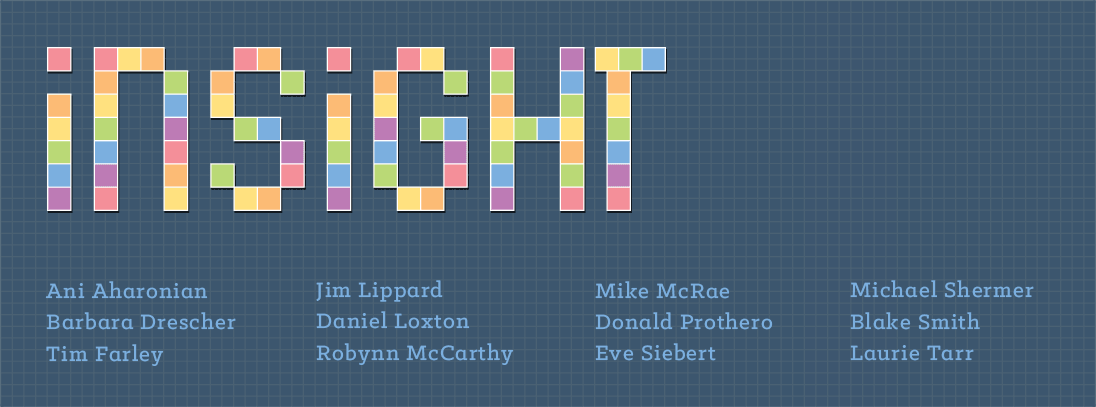
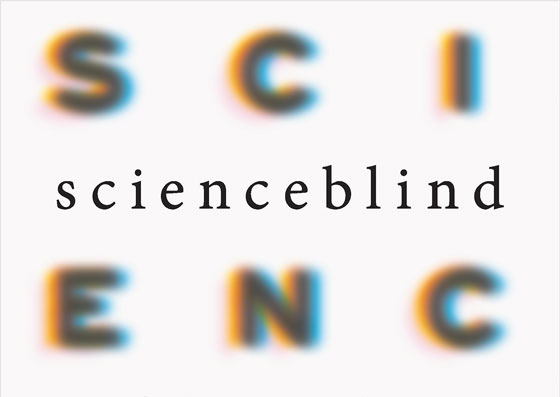

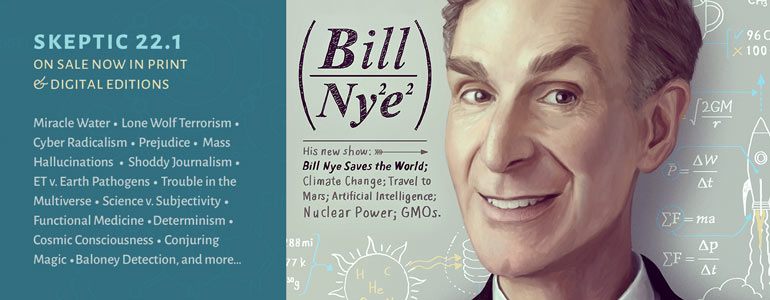
![An image of Marshall Applewhite during a video broadcast produced by Heaven's Gate (religious group) [https://en.wikipedia.org/wiki/File:Marshall_Applewhite.jpg]](https://www.skeptic.com/eskeptic/2017/images/17-03-29/Marshall_Applewhite.jpg)
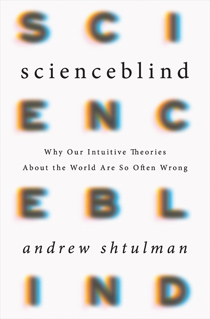
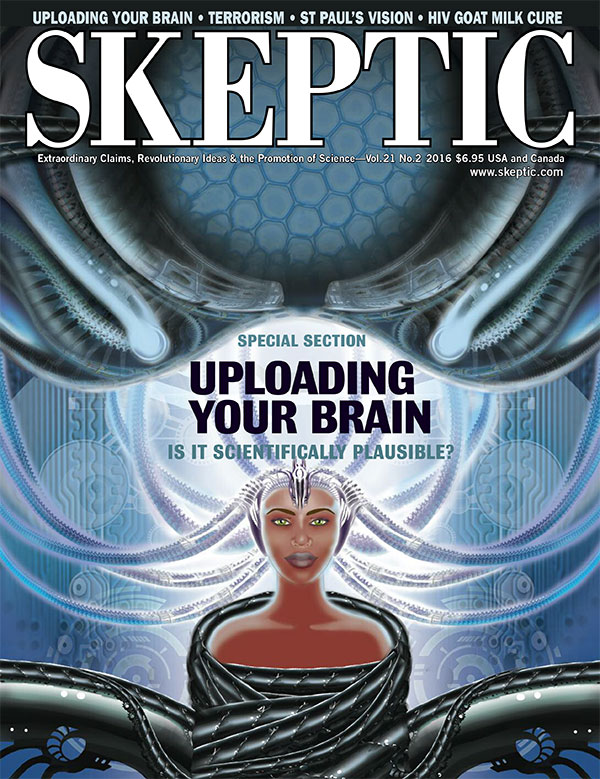
![A sexual orientation symbol created by AnonMoos [Public domain], via Wikimedia Commons](https://www.skeptic.com/eskeptic/2017/images/17-03-15/Whitehead-link-alternative-sexuality-symbol-2x.png)
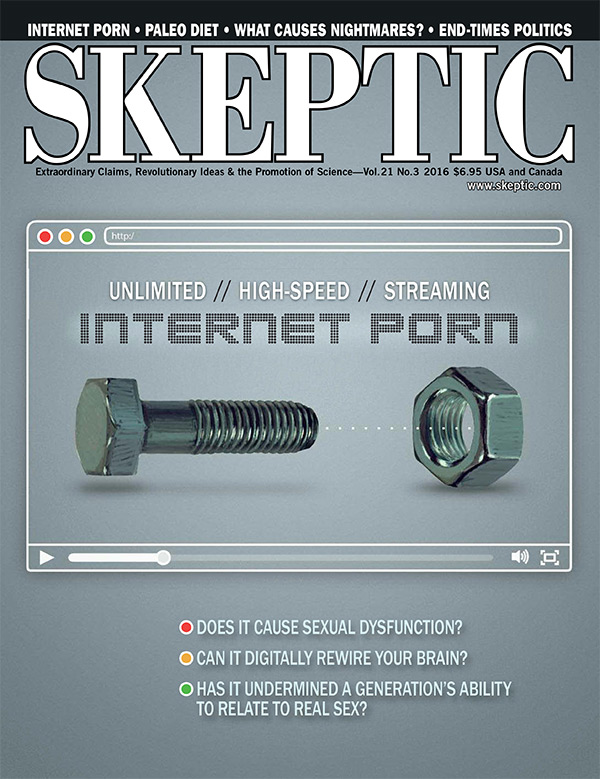
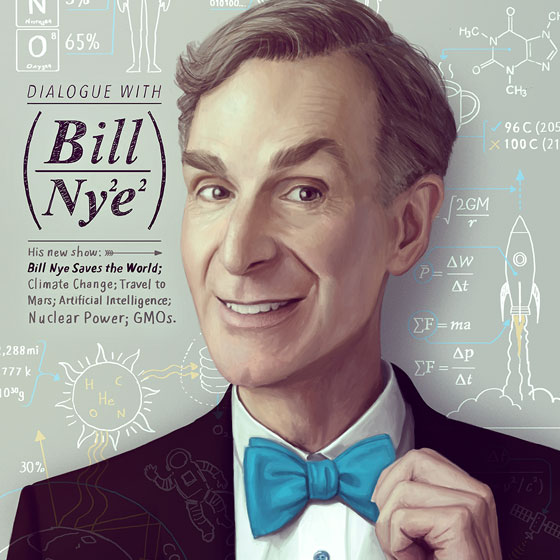


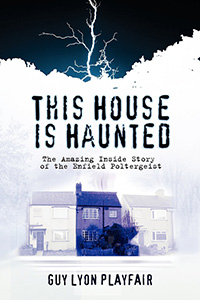
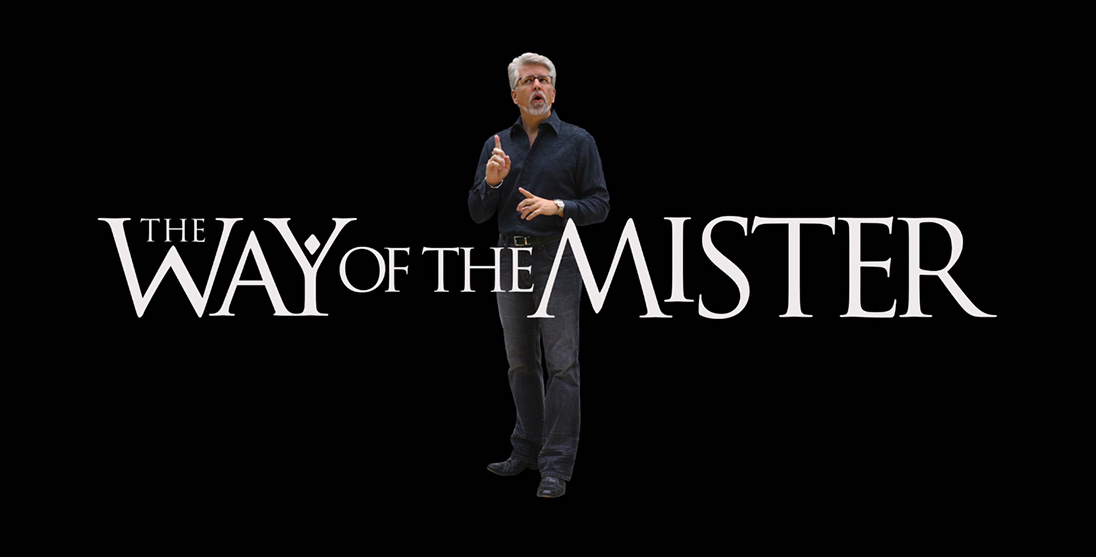
![The Fountain of Youth by Lucas Cranach the Elder [Public domain], via Wikimedia Commons](https://www.skeptic.com/eskeptic/2017/images/17-03-01/Lucas_Cranach_-_Der_Jungbrunnen_(Gemaldegalerie_Berlin).jpg)
